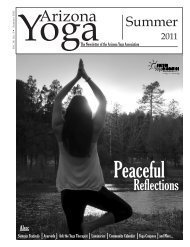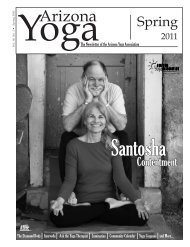Spring 2009 - Arizona Yoga Association
Spring 2009 - Arizona Yoga Association
Spring 2009 - Arizona Yoga Association
You also want an ePaper? Increase the reach of your titles
YUMPU automatically turns print PDFs into web optimized ePapers that Google loves.
connect bone to bone, like our ACL at the knee, and tendons,<br />
which connect muscle to bone, like the Achilles tendon at<br />
the ankle.<br />
Any action affects the connective tissue. This metaphor can<br />
easily be seen with the shirt you are wearing. Sit up straight<br />
and straighten your shirt. Begin to twist any section of the<br />
shirt and you will notice wrinkles forming and lines climbing<br />
in all directions. Our inner layer is constantly reshaped and<br />
reformed due to our movements and our daily actions.<br />
Yet, there is a difference in the effect our practice will have<br />
on the connective tissue around joints, the ligaments,<br />
tendons, and fascia between bones, compared to a practice<br />
that stimulates our connective tissue and the muscle. When<br />
muscles are engaged, they stabilize and protect the joint<br />
connective tissue, limiting the impact. We would not want<br />
our joints to collapse in the midst of an arm balance, or while<br />
balancing in tree pose. This stabilization of our connective<br />
tissue is a primary reason Western medicine considered these<br />
tissues stable and unchanging. Any activity that deemed to<br />
manipulate them was considered dangerous and unhealthy.<br />
Yin <strong>Yoga</strong> founder Paul Grilley, Dr. Motoyama and Master<br />
Martial Arts Paulie Zink demonstrate this theory is incomplete.<br />
While practitioners should avoid any activity that causes<br />
destabilization, whether in a Yin (relaxed) or Yang (muscular)<br />
interaction, the connective tissue is as malleable as the muscle<br />
fascia, and should be engaged and exercised regularly, as well.<br />
In fact, the connective tissue plays a larger role in the range of<br />
motion our muscles can enjoy, and should simply be engaged<br />
in a different manner, a Yin manner.<br />
This Yin manner places the focus on the ligaments, tendons<br />
and fascia surrounding the joints, primarily the joints of our<br />
lower back, our hips and our knees. Freedom in these joints<br />
will translate to comfortable sitting position for long periods<br />
of time.<br />
Faced in the West with long hours of sitting in a chair, the<br />
connective tissues around these joints contracts, compresses<br />
and over time loses much of its lubricating synovial fluids,<br />
leaving individuals with limited range of motion, discomfort<br />
and pain.<br />
Interestingly, the acupuncturist view of these consequences<br />
is a lack of energetic flow along the meridians of our hips<br />
and back, the Kidney and Urinary Bladder meridians, in<br />
particular.<br />
By engaging our bones to their edge, placing them at their<br />
deepest range of motion, just beyond our comfort zone,<br />
releasing muscular activity, and holding the pose for long<br />
periods of time, five minutes or more, the connective tissues<br />
receives a fresh surge of synovial fluids, which keeps it healthy,<br />
lengthens and elongates it and stimulates energetic flow<br />
throughout the body.<br />
While Yin <strong>Yoga</strong> will increase range of motion, help alleviate<br />
strain and tension in your joints and leave you feeling<br />
refreshed and alive, Dr. Motoyama points to a greater benefit.<br />
Our life force, the energy that sustains us, is stimulated and<br />
its flow increased. Furthermore, as this energy flows along<br />
the connective tissue channels, relaxed muscles enhance this<br />
stimulation, while tight, condensed muscles limit it.<br />
“Feel, or no feel” Can you feel this energy moving through<br />
your body Thai master Pichest Boonthume urges practitioners<br />
to go beyond the gross expression of skin and muscle, to the<br />
subtle domain of energy in the body. A master of energy,<br />
Pichest can feel where energy flows freely and where it is<br />
blocked. His intuitive experience allows him to simply look<br />
at someone and know where that energy is blocked; yet this<br />
intuitive sensation starts with feeling his own body.<br />
Thai <strong>Yoga</strong> is an energy-sharing system expressed through the<br />
physical body. An ancient system, based on <strong>Yoga</strong> postures and<br />
the effect these postures have on our physical and energetic<br />
body, it involves a practitioner stretching and pressing on<br />
another body. Popularly called “<strong>Yoga</strong> for the lazy person,” it<br />
is founded on the same principles that make Yin and Yang<br />
<strong>Yoga</strong> so effective.<br />
Thai <strong>Yoga</strong> is a practice where students learn how to move<br />
their bodies, through very specific positioning and breathing.<br />
Inspired by Thai Massage, the healing system in Thailand,<br />
Thai <strong>Yoga</strong>’s focus is less on the person who is receiving and<br />
more on the experience of the practitioner. Through practice,<br />
one develops a sensory awareness on where movement is<br />
limited, indicating less energy flow, whether muscles are dense<br />
and hard like taffy, or soft and relaxed like marshmallow, and<br />
the sense of connection that underlies the differences between<br />
the two forms.<br />
Here as well, energetic flow is determined by the softness<br />
and elasticity of the ligaments and tendons. The softer the<br />
muscles, the more relaxed the connective tissue, the stronger<br />
energetic flow through the tendons. Coordinated with the<br />
breath, specific presses and extensions produce a response<br />
that travels throughout the connective tissue, increasing blood<br />
circulation, enhancing neural response and inducing them<br />
into a relaxed position.<br />
Breath awareness, coupled with an opportunity to relax<br />
through external pressure, teaches practitioners the value of<br />
letting go.<br />
We tend to believe that we have to work hard in order to<br />
achieve something. We feel we had the best <strong>Yoga</strong> class, or the<br />
best workout if we can barely walk at the end of practice. For<br />
10 <strong>Spring</strong> <strong>2009</strong> • ARIZONA YOGA




